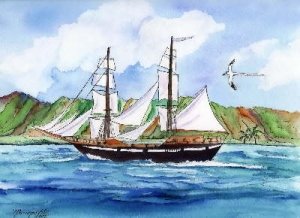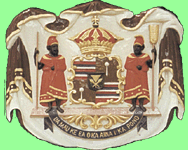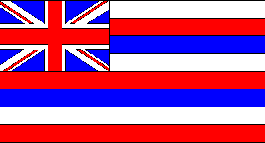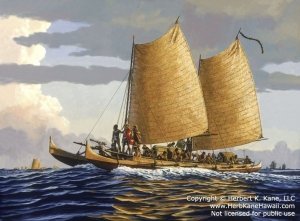History of Hawaii
I will declare the decree: the Lord hath said unto me,
Thou are my Son: this day have I begotten thee.
Ask of me, and I shall give thee the heathen for thine inheritance,
and the uttermost parts of the earth for thy possession.
Psalms 2:7-8
It is difficult to find an objective Hawaiian history that is accurate and unemotional. However, we have tried to share here what we believe to be the facts that may help to support a wholesome future for Hawaii. If you find anything to be incorrect please let us know, we will be happy to make any verifiable corrections.
AD 400
Estimated to be the time of the first explorers to Owhyhee from southeast Asia and the Marquesas Islands, a gentle people free of class subjugation and war. I have personally seen their intricate work on the exquisite fish ponds of Kauai. Sometimes called the Melanesian Polynesians and even sometimes thought to have been the mythical Menehuni of the Polynesian Hawaiian legends.
AD 900-1100
The Immigration
These immigration of warlike people from Tahiti enslaved the previous migrations of people and the leaders maintained rule by fear and violence, smashed heads, gouged eyes, branding, drowning, strangulation, decapitation, live burials and roasting alive to name only a few of the methods of rule. The Tahitian immigration brought a warring people who took peace from the land for nearly a thousand years. The common people lived in everyday fear of death and in slavery. Even the shadow of a commoner falling across the feet on an Alii could cause death.
1758
King Kamehameha
King Kamehameha was born on Hawaii Island in Kohala. And grew to see a dream of unifying the Island under his absolute authority.
1/18/1778
Isolated by time and space, alone and surrounded by the Pacific Ocean for thousands of miles in all directions lies Hawaii, the uttermost parts of the earth. The Estimated population of Hawaii at this time was between 300,000 to 500,000. Captain James Cook did not discover Hawaii until 286 years after the discovery of the Americas. Cook took a year exploring the Islands laying in provisions and making ships repairs. The first contact with Hawaii fit a prophecy concerning the coming of the god Lono and the ship was royally greeted and supplied this first time. But unfortunately, Cook did not know that the prophecy concerning Lono did not predict a return visit. Cook returned needing repairs and provisions. Due to the attempted theft of a shore boat for the metal by the Hawaiians and suspicion that Capt. Cook was not really the god Lono, on February 14th a skirmish broke out at Kealakekua Bay. Capt. Cook tried to intervene and was stuck and began to bleed. The Hawaiians then knew that they had been tricked and killed Capt. Cook with the next blows. Captain Clarke the second in command of the mission wanted to smooth things over with the Hawaiians and make peace with the chiefs. A few more skirmishes occurred but on the 21st of February 1778 the Hawaiians returned some of Captain Cook’s bones and there was tenuous peace.
1779?
The chiefs and alii were constantly fighting for power. From among these warring chiefs arose Kamehameha, known as the Great. Kamehameha was born in Kohala on the Island of Hawaii, also called the Big Island. Kohala was the first volcano in the building of the Island and therefore the oldest. (Up till the last 50 years it was if the area was locked in time, beautiful place to visit.) There are temple sites, like Mo’okini Heiau that date back to perhaps 1,000 AD. In So. Kohala the war god of Kamehameha, Kuka’ilimoku, was the inspiration for this 100′ x 224′ heiau in 1791. The temple was dedicated with the blood sacrifice to Ku of Kamehameha’s invited cousin Keoua. The death of Keoua ended all opposition to Kamehameha on the Island of Hawaii. Two young British seaman, Isaac Davis & John Young were responsible for bringing Kamehameha into the knowledge of gun powder and cannon. This is considered a primary factor in the conquest of the Hawaiian Islands by Kamehameha. He was greatly impressed by the English technology and craftsmanship. The King found tutors and advisors and gathered war expertise in exchange for lands, slaves and wives. With this British expertise he began to controlled trade and later subjugated Maui and Oahu by cannon by war canoe from his base on Island of Hawaii and by 1810 had become a very powerful and wealthy Hawaiian King. (Kauai was not conquered but later did submit by threat to Kamehameha’s rule) to become their King and unify the Hawaiian Islands.
The fur traders and merchant ships heading to China realized they could economically barter for provisions in Hawaii. For instance any type of iron, a common nail, chisel, or knife, could fetch far more fresh fruit meat and water than a large sum of money would in any other port. The Hawaiian alii (royalty) and chiefs were eager to obtain modern weapons and rewarded those captains who supplied them handsomely. The captains of these ships not only sought food and supplies, but manpower. As it was a frequent occurrence for sailors to die or desert on these voyages good willing sailors were hard to find. The strong adventurous Hawaiians were more than up to the task of sailing on these tall ships. Five of these adventurous Hawaiian sailors Henry Obookiah*, Thomas Hopu, William Kanui, John Honolii, and George Tamoree made it to New England where they became Christians. These young men looking for adventure, all were converted to Christ as Lord in there own unique way. Their desire was to return to Hawaii to bring the “torch of life” , Christianity, to their people.
These trader contacts also began the serious plagues of the “trader’s diseases” including STD’s, Leprosy, and many other diseases for which the Hawaiians had no immunities. In time the Hawaiian population would plummet from three to five hundred thousand in 1778 to only thirty thousand by 1900.
The Hawaiian religious system demanded death for the breaking of a kapu. If men and women ate together, the penalty was death. If a woman ate pork or certain fish or bananas the penalty was death. If the shadow of a commoner fell on an alii or chief the penalty was death. The Hawaiian gods were hard taskmasters demanding all manner of sacrifice and offerings. The Kapu system was enforced by the alii who gave authority to the high chiefs and the high chiefs gave power to their various sub‑chiefs and at the bottom of the system was the commoner Hawaiian. All of the commoners were slaves to the chiefs and the chiefs were slaves to the alii. Nothing was ever owned by the people, it could only be used by the permission of the chief or Alii for his purposes.
1800
British Crown Colony
By this time King Kamehameha, I was ruling like a British Crown Colony with uniforms of the Court of St. James with helmets, gold-brad, cannons, and the Union Jack. Many Hawaiians were killed due to his forced unification of the Islands of Hawaii. Whole villages were pushed off of the Pali in Oahu to their death.
In one of these battles for power between two warring chiefs, Henry Obookiah* at the age of about twelve helplessly watched as his parents were butchered before his eyes. Henry escaped with his infant brother, but as he was running with his brother slung over his back the child was struck with a spear and also died. Henry was then forced to live as a slave with the man who killed his mother and father. It appeared he would be sacrificed to a god as the other prisoners with him had just been thrown over a cliff as a sacrifice. Being alert to the peril he took a chance and escaped. Shortly after that an uncle who was a priest rescued him and took him in. Life in Hawaii had not been good to Henry and when he saw that tall ship, the Triumph in Kealakekua Bay he swam out to it, with all the hopes and desires of leaving Hawaii for a better life. Captain Caleb Brintnall through interpreters realized Henry wanted to leave Hawaii on his ship. Henry now about fifteen years old was signed on as a cabin boy. Henry met Thomas Hopu another Hawaiian boy in search of adventure on the ship. Both Henry and Thomas would become original members of the American Board Mission to Hawaii; though only one would return to Hawaii. As fate would have it at the age of 26 in Cornwall Connecticut, Henry would succumb to the typhus fever on February 17th, 1818. Henry’s Christian testimony was published and became a best seller. The profits of the book “Memoirs of Henry Obookiah” were used to finance the missionary journeys to Hawaii and other lands.
Inspired and encouraged by the dramatic testimony and conversion of Henry Obookiah the first missionaries sailed for Hawaii, on October 23rd, 1819 aboard the Thaddeus. The Missionaries had left all their future in America and had sold all that they possessed, farms, homes to come to Hawaii. They had made a solemn commitment to God and each other to spend the rest of their lives serving the Hawaiian people in virtual poverty with only their stipends from New England.
Yet, they knew all to well that they needed the approval of King Kamehameha and that the Kapu Priests would not welcome their presence. On the morning of March 30th, 1820 the missionaries saw Hawaii for the first time. The Thaddeus cruised along the Kohala coast on a southwest course nearing Kawaihae. The wind and water became calm so Captain Blanchard sent a small rowboat with James Hunnewell a ship’s officer, Thomas Hopu and John Honolii two of the Hawaiian Missionaries ashore. Their task was to find out the whereabouts of King Kamehameha and the state of his kingdom. One disapproving word from the King and the mission would be over before it had begun. Minutes passed like hours as they watched for the boats’ return. Finally after three hours, an eternity, the boat returned. Thomas and John were so excited they could only speak in Hawaiian.
Nov. 1819
The death of Kamehameha

The kapu system was finally destroyed by the Hawaiian Monarchy and the priests & kahunas were overthrown, killed or dispersed, temples were demolished and the kapu’s shattered. This was the end result of the bondage and pain caused by the kapu system and the privileged treatment that was demanded by the kahunas. This action resulted in both peace and a great spiritual vacuum for the Hawaiians as a people.
3/30/1820
The ship Thaddeus

It was obvious to the missionaries that God had prepared the way for them. The great Hawaiian miracle had taken place all of the obstacles that could have prevented the Gospel from being preached had been removed. Even Hewahewa the highest kahuna (priest) and direct descendant of Paau, the original Kahuna from Tahiti, was the first to set fire to a heiau (temple). He declared: “I knew the wooden images of deities, carved by our own hands, could not supply our wants, but worshiped them because it was a custom of our fathers. My thoughts has always been, there is only one great God, dwelling in the heavens.” Hewahewa also prophesied that a new God was coming and he went to Kawaihae to wait for the new God, at the very spot were the missionaries first landed.
King Kamehameh died five months before the missionaries sailed but they had no knowledge of his death before their departure. In less than the span of one year from his death, and as the missionaries were at sea, the Kapu system had been dissolved, and a civil war had taken place. Only the creator of the universe, Jehovah, could have scripted these timely events. In the midst of this chaos, the stage is divinely set for the entrance of the missionaries with the Gospel of Jesus Christ. The missionaries brought a message of peace, tranquility, and Aloha.
I am the Lord: that is my name: and my glory will I not give to another, neither my praise to graven images. Behold, the former things are come to pass, and new things do I declare: before they spring forth I tell you of them. Sing unto the Lord a new song, and his praise from the end of the earth, ye that go down to the sea, and all that is therein; the isles, and the inhabitants thereof. Let the wilderness and the cities thereof lift up their voice, the villages that Kedar doth inhabit: let the inhabitants of the rock sing, let them shout from the top of the mountains. Let them give glory unto the Lord, and declare his praise in the islands. Isaiah 42:8‑12 (hot link to “Perpetuated in Righteous”, Further Information)
6/7/1839
Declaration of Rights by Kamehameha III
6/17/1839
Edict of Toleration
8/8/1840
Written Constitution
Written Constitution was made with missionary influence to maintain Hawaiian independence from foreign countries like the United States, Britain and France.
7/31/1843
Kamehameha III
Kamehameha III spoke the words that have become the motto of Hawaii: “Ua mau ke ea o ka aina i ka pono” at Kawaiahao Church “The life of the land is perpetuated in righteousness.”
1848-50
Land reapportionment
Land reapportionment, (The distribution of land ownership to the common people.) And the great measles epidemic with very serious STD’s (sexual transmitted disease) problems.
1853
Trader’s Diseases
By this time the Hawaiian population was being greatly reduced by the “trader’s diseases”. Population was then estimated as: 70,000 Hawaiian, 983 part Hawaiian, 1,687 Caucasians, 364 Chinese, 5 Filipinos, 62 other? By 1900 there was less than 10% of the original Hawaiian population left or about 30,000 Hawaiian people. The people were generally not heeding the missionary’s cry for celibacy or a monogamous relationships in marriage. We have the same problem today with STD’s and AIDS worldwide. Had the missionaries not come in 1820 it is doubtful that any of the Hawaiian people would be alive today.
12/15/1861
King Kamehameha IV (Alexander Liholiho)
King Kamehameha IV (Alexander Liholiho) and Queen Victoria of England with the concurrence of the Archbishop of Canterbury did establish the Hawaiian Reformed Catholic Church. This church remains to this date but the property was turned over to the Episcopal Church of the United States with the take over of the provisional government in 1902. This original church was the Anglican Church of England, selected by the Monarchy as their choice of worship for themselves.
1865
Congregational Missionaries
The church/home support was terminated for the Congregational Missionaries. Other faiths were also now at work: Catholic, Mormon, Episcopal and other religions from the Chinese, Japanese, Portuguese, Filipinos and Puerto Ricans. The missionaries now found themselves responsible for their own support in Hawaii. When it became necessary for the missionaries to either return to New England with all of their families or to become self supporting in Hawaii, they elected to stay and to become self supporting.
1874
The reign of King Kalakaua
The reign of King Kalakaua lasted 17 years and enjoyed a great resurgence of Hawaiian culture. Queen Liliuokalani was defeated as sovereign under a Constitutional Monarchy vote. Kalakaua and Liliuokalani were not friends and were not in accord as to how to rule Hawaii.
1875
Reciprocity Treaty
King Kalakaua signs the Reciprocity Treaty with the United States
1891
King Kalakaua
King Kalakaua was a 33 degree Mason and built the Iolani Palace requiring many loans. He was known for gross extravagance and placed the Hawaiian Kingdom into very serious debt. Large tracts of land were also traded for the money to build the palace. He died of Bright’s disease at the age of 54.
1/29/1891
Queen Liliuokalani
Queen Liliuokalani was sworn into office, and immediately began to try to quickly undue the political legacy of King Kalakaua and ratify a new constitution restoring power to the Hawaiian people. At this time the immigrants to Hawaii outnumbered the Hawaiian people by four to one.
1/4/1893
The Queen forced the former Wilcox cabinet of Kalakaua to resign and headed in a new direction for Hawaii with a new constitution in which the monarchy and the 30,000 remaining Polynesian Hawaiian’s would restore authority of the small Nation of Hawaii to the Monarchy.
The Queen signed the lottery and the opium bills into law and proclaimed the new constitution. The new constitution would restore power to the crown. The newly selected Queen’s Cabinet Ministers refused to sign the new constitution into law and justly feared a violent conflict between the different interest groups now in Hawaii.. The new constitution was tabled for 2 weeks due to threats of violence and possible loss of property. During those two weeks a provisional government was appointed. The then provesional Government of Hawaii then requested to be placed under the United States for protection during the ensuing negotiations.
2/19/1893
The provisional government sent a five man commission to Washington, D.C. to negotiate a treaty of union with the U.S. The Queen’s envoys were also sent to Washington but against the Queen’s instructions they also talked freely in favor of Hawaiian annexation when they arrived in Washington, D.C.
7/4/1894
The Republic of Hawaii
The Republic of Hawaii was instituted out of fear that the U.S. might not extend protection to the emigrants, settlers and business owners in Hawaii. This was a sad day for all concerned.
1894-98?
Third
Third, – I proposed (Queen Liliuokalani) to issue licenses for the importation and sale of opium. I did think it would be wise to adopt measures for restricting and controlling a trade which it is impossible to suppress. With a Chinese population of over twenty thousand persons, it is absolutely impossible to prevent smuggling, unlawful trade, bribery, corruption, and every abuse. There were more scandals connected with the opium traffic than I have the time to notice here. Some of the most prominent citizens have been connected with these affairs, and frauds have been unearthed even in the custom-house itself. The names of Mr. Parks, of Mr.W. F. Allen, and more recently of Mr. Henry Waterhouse, have been associated with some very questionable dealings in this drug; and it may be doubted whether the practice of hushing up such matters is favorable to good morals in any community. The Provisional Government seems to have had no scruples in the matter; for the sons of the missionaries exported a large quantity of confiscated opium, and sold it for fifty thousand dollars in British Columbia. The British government has long since adopted license instead of prohibition, and the statute proposed among the final acts of my government was drawn from one in use in the British colonies; yet I have still to learn that there has been any proposition on the part of the pious people of London to dethrone Her Majesty Queen Victoria for issuing such licenses. (Hawaii’s Story by Hawaii’s Queen by Liliuokalani, Queen of Hawaii (1838-1917). Boston: Lee and Shepard, 1898.)
1897
The Annexation of Hawaii
In protest to the annexation of Hawaii to the U.S. a Japanese warship arrives in Pearl Harbor. The U.S. Congress debates the annexation treaty over the next three years. About 40% of the Hawaiian population was Japanese at this time.
6/14/1900
A Territorial Treaty
A Territorial Treaty is signed with the United States. The population then stood at: 30,000 Hawaiians, 10,000 part Hawaiians, 27,000 Caucasians, 26,000 Chinese, 61,000 Japanese. There was a major concern that the Japanese would try to incorporate Hawaii due to the high number of Japanese immigrants. The total population was at about 151,000 at this time.
12/7/41
The Japanese attacked Pearl Harbor
The Japanese attacked Pearl Harbor believing that the Hawaiian Japanese would remain loyal to Japan, fortunately, they did not. But unfortunately many were interred in holding facilities in California. This was a very dark day for the Japanese immigrants.
8/21/1959
Statehood for Hawaii
Hawaiian statehood was voted in by all the registered voters of Hawaii in a general election. It was felt by many that Hawaii as a State would be less vulnerable to invasion. At the time there was great enthusiasm and many parties proclaiming Statehood for Hawaii.


